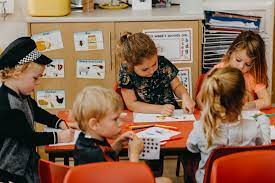The transition to school is a significant milestone in a child’s life. It’s not just about swapping playtime for reading and arithmetic—it’s about adapting to a new environment, building relationships, and developing independence. Understandably, this big day can be both an exciting and anxious time for children and parents alike. Here’s how we help children transition to school, ensuring a smooth and positive experience.
1. Building Familiarity:
One example of the primary anxieties children face is the unknown.
- School Tours: By organizing tours of the school, we give children a chance to explore their new environment. Familiarity breeds comfort.
- Meet the Teacher Sessions: We arrange for children to meet their teachers before school starts, making the first day feel like meeting an old friend.
2. Structured Routines:
Routine provides a sense of security for children.
- Practice Runs: We suggest doing a few practice runs of the school day routine—waking up, getting dressed, having breakfast, and going to school. This makes the actual routine feel more natural.
- Visual Schedules: Using visual aids, we help children understand what to expect during their school day.
3. Social Skills Development:
School isn’t just about academics; it’s about forming new friends, and social connections.
- Group Activities: Before school starts, we organize group activities to help children practice skills like sharing, waiting their turn, and active listening.
- Story Sessions: We read stories that tackle themes of friendship, sharing, and dealing with emotions, providing children with valuable insights.
4. Emotional Support:
Acknowledging and addressing the emotional upheaval children might feel is crucial.
- Open Conversations: We encourage parents to talk to their children about their feelings, concerns, and excitement.
- Role-playing: Acting out scenarios like saying goodbye to parents, asking the teacher a question, or making a new friend can prepare children for real-life situations.
5. Independence Building:
School requires a certain level of independence, self esteem, and we help foster and develop that.
- Self-help Skills: We teach children skills like packing their bags, keeping track of their belongings, and opening their lunch boxes.
- Decision-making Opportunities: Simple choices, like picking out their school clothes or selecting a snack, can bolster a child’s confidence.
6. Parental Workshops:
The school transition also isn’t just about the children; parents need support too.
- Information Sessions: We host sessions where parents can learn about the school’s curriculum, policies, and ways to support their child’s education at home.
- Support Groups: Connecting with other parents provides a valuable support network where experiences and advice can be shared.
Primary School
Primary school, also known as elementary school in some regions, serves as the foundational phase in a first child’s transition to formal education. This stage plays a pivotal role in shaping a child’s academic journey, social interactions self confidence, and overall worldview. Let’s delve into the essence, structure, and significance of primary schooling.
1. The Age Bracket:
Typically, primary school caters to children aged between 5 and 11, although the specific ages to start school at can vary slightly depending on the country or educational system. The school journey often begins with a preparatory or kindergarten year and culminates in what some regions might term the reception year of 5th or 6th grade.
2. Curriculum Structure:
Primary schooling offers a broad curriculum to provide students with a well-rounded foundation. Core subjects often a child starts school include:
- Mathematics
- Language Arts (reading, writing, listening, and speaking)
- Science
- Social Studies or History
- Physical Education
Additionally, students might be introduced to:
- Arts (visual arts, music, drama, etc.)
- Computer or Technology Education
- Foreign Languages
3. Developmental Focus:
The emphasis during these years is not solely academic. There are other families there’s a strong focus on:
- Social skills: Sharing, collaboration, and conflict resolution.
- Emotional skills: Empathy, patience, and handling emotions.
- Cognitive development: Critical thinking, problem-solving, and creativity.
4. Teaching Methodologies:
Primary and secondary school, educators often employ a variety of different school and of teaching methods to cater to diverse learning styles:
- Hands-on activities and experiments
- Storytelling and reading sessions
- Group projects and team-based tasks
- Interactive digital tools and educational apps
5. Evaluation & Assessment:
Assessment in primary school is generally continuous and varied. It aims to gauge a student’s understanding new school,, skills, and progress rather than just rote memorization. Techniques include:
- Quizzes and tests
- Project work
- Oral presentations
- Class participation
- Portfolio assessments
6. Extracurricular Activities:
Beyond the academic curriculum, primary schools often offer extracurricular activities and resources like:
- Sports teams or physical activity clubs
- Art or music clubs
- Science clubs or eco clubs
- Drama or theatrical performances
7. Parental Involvement:
Parents play an instrumental role in both you help your child through primary education. Schools often encourage:
- Regular parent-teacher meetings
- Participation in school events or field trips
- Volunteering opportunities within the school
Starting School: Navigating the First Steps of the Academic Journey
Beginning school is a milestone not only in a child’s life but also for parents and caregivers. This momentous occasion is filled with a myriad of emotions ranging from excitement to anxiety and worry. Whether it’s the very first day of preschool, kindergarten, or the first few weeks of primary school, each step represents a new chapter in a child’s growth and development.
The Role and Importance of a Child’s Key Person in Early Years Education
In the realm of early years education, the idea of the term ‘key person’ (sometimes referred to as ‘key worker’ or ‘primary caregiver’) holds significant importance. This individual plays a pivotal role in a child’s developmental journey, ensuring they feel safe, nurtured, and valued within an educational setting.
Who is a Key Person?
A key person is an educator or caregiver designated to one or more children, particularly in early years settings like nurseries or preschools. Their role goes beyond general caregiving and instruction; they form a bond with the the child’s teacher, acting as the primary point of contact between the educational setting and the child’s family.
2. Responsibilities of a Key Person:
- Building Relationships: The key person builds a trusting relationship with the child, helping them settle into the new environment and feel secure.
- Observation and Assessment: They observe the child’s activities, interactions, and overall progress, documenting developmental milestones and any areas of concern.
- Communication: The key person maintains open communication with parents or guardians, updating them about the child’s achievements, challenges, and daily experiences.
- Personal Care: For younger children, the key person often assists with personal care needs, such as diaper changes, feeding, or naptime.
- Emotional Support: They provide emotional support, helping the child navigate feelings, build friendships, and handle any anxieties or concerns.
3. Why is a Key Person Important?
- Consistency and Security: Children, especially during their early years, thrive on consistency. Having a familiar face and a consistent caregiver offers a sense of stability and security.
- Personalized Care: By focusing on a limited number of children, a key person can tailor their care and attention to the individual needs of each child.
- Parental Peace of Mind: For parents, knowing there’s a dedicated individual who understands and prioritizes their child’s needs can be reassuring.
- Smooth Transition: A key person plays an instrumental role when a child is transitioning to a new class or setting, ensuring the process is as seamless as possible.
4. Qualities of an Effective Key Person:
- Empathy and Understanding: They should be able to tune into a child’s emotions and needs.
- Good Communication Skills: This includes communicating with children, their families, and other staff members.
- Observational Skills: An effective key person can notice subtle changes in a child’s behavior, progress, or well-being.
- Patience: Working with young children requires immense patience and the ability to handle challenges calmly.
Nursery
The nursery, with its blend of structured learning and free play, stands as a cornerstone in a child’s developmental journey. It’s where cognitive abilities are honed, social skills are developed, and emotional resilience is built. As children transition from the nursery, they carry with them not just knowledge, but memories new routines, friendships, and foundational skills that will serve them well in the years to come.
Why Develop Independence Matters:
Independence is a life skill that extends far beyond the immediate tasks of childhood. It cultivates qualities such as critical thinking, problem-solving, and self-confidence. By encouraging independence, parents and caregivers lay the groundwork for children to become responsible, capable adults.
In Conclusion:
The phrase “how we help children transition to school” encapsulates more than just preparing children adjust for them academically. It’s about nurturing their emotional well-being, fostering independence, and ensuring they are socially equipped. With the right support, this transition big school can be a joyous journey, laying the foundation for many successful school years to come.



Recent Comments